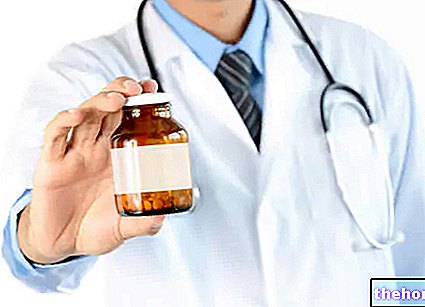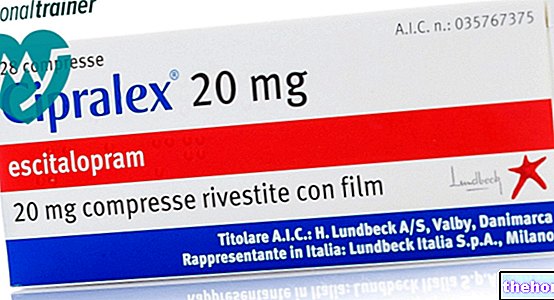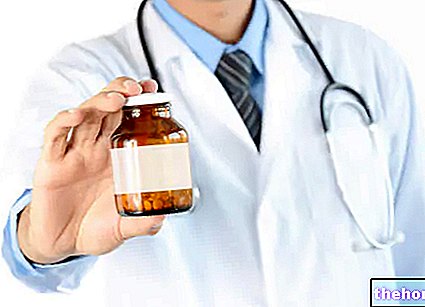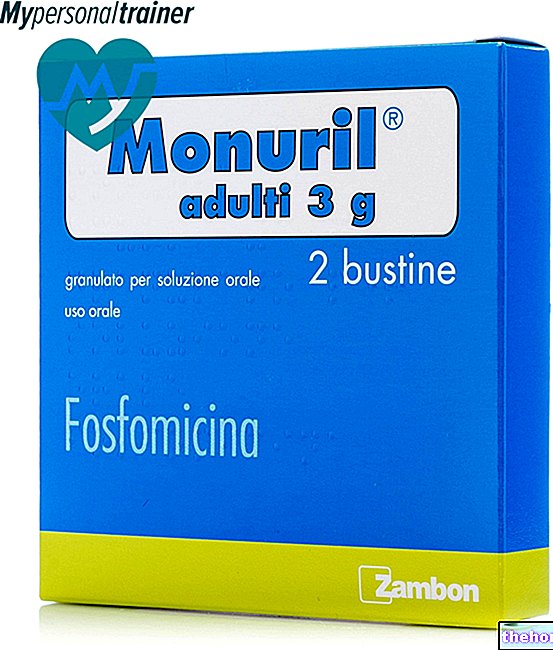Active ingredients: Chlorphenamine (chlorphenamine maleate)
Trimeton 10 mg / 1 ml solution for injection
Indications Why is Trimeton used? What is it for?
Trimeton 10 mg / 1 ml solution for injection is a medicine with antihistamine properties (ie capable of fighting allergies) that belongs to the class of antihistamines, and is effective in solving symptoms deriving from allergic diseases of the upper respiratory tract and of the skin.
Trimeton is indicated for:
- the treatment of symptoms of seasonal and perennial allergic rhinitis, vasomotor rhinitis, an eye disease characterized by intense itching and tearing, usually due to the presence of pollen (allergic conjunctivitis), skin rashes that are the manifestation of allergic diseases (uncomplicated allergic skin manifestations of urticaria and angioedema), itching, insect bites and some allergic reactions caused by contact between the skin and an irritant (allergic dermatosis) such as atopic dermatitis;
- supportive therapy in allergic reactions to drugs, blood transfusion (serum) or vaccines;
- the treatment of a neurological disorder that some experience following rhythmic or irregular movements of the body in motion (motion sickness) and vomiting.
- TRIMETON is indicated when a rapid effect of therapy is required.
What are allergic rhinitis (seasonal and perennial) and vasomotor rhinitis?
Seasonal allergic rhinitis that appears at certain times of the year is an allergic reaction caused by the inhalation of pollen and molds.
Perennial rhinitis occurs year round and symptoms can be caused by sensitivity to a variety of causes, including house dust mites, animal hair, feathers and certain foods. These allergies cause nasal discharge, sneezing and swelling of the nasal mucous membranes, which cause a feeling of obstruction.
Vasomotor rhinitis, on the other hand, is not an allergic reaction and can be triggered by various non-specific stimuli, such as: changes in the ambient temperature; exposure to light; inhalation, even in minimal quantities, of irritating gases, dusts or vapors; hormonal changes (in relation to the menstrual cycle, the first months of pregnancy, menopause, an excessive functioning of the thyroid gland, a gland located in the neck); medical therapies, such as some medicines for hypertension; violent emotions.
Contraindications When Trimeton should not be used
Do not use Trimeton
- if you are allergic to the active substance, to other similar antihistamines or to any of the other ingredients of this medicine
- in infants and premature babies;
- in children under the age of 12;
- if you are taking therapy with medicines used to treat depression (monoamine oxidase inhibitors);
- if you have a disease of the bronchi (lower airways);
Precautions for use What you need to know before you take Trimeton
Talk to your doctor or pharmacist before using Trimeton.
Use Trimeton with caution:
- if you have a severe form of glaucoma, which is an eye disease caused by an increase in the pressure of the fluid inside the eye (closed-angle glaucoma);
- if you have a lesion of the mucosa of the upper digestive system which leads to its narrowing (stenosing peptic ulcer);
- if you have a narrowing of the pylorus, the valve that allows digestive food to pass from the stomach to the intestine (pyloric stenosis); if you have a narrowing of the duodenum, the initial part of the intestine (duodenal stenosis);
- if you have an enlarged prostate, a gland that produces seminal fluid in men (prostatic hypertrophy);
- if you have a narrowing of the bladder neck;
- if you have bronchial asthma, a respiratory disease characterized by an obstruction of the bronchi;
- if you suffer from epilepsy, a disease characterized by episodes of convulsions.
- if you have cardiovascular disease;
- if you have high blood pressure;
- if you have a high pressure of the fluid contained inside the eye;
- if you have a thyroid gland, a gland in the neck that is over-functioning (hyperthyroidism)
- if given to you for the prevention of allergic reactions in case of blood transfusions Trimeton should not be mixed with blood from transfusions, but should be given directly before the transfusion
- If you are given subsequent transfusions, you will receive another dose of Trimeton.
Senior citizens
Antihistamines are more likely to cause dizziness, mental and muscle relaxation, and lower blood pressure in elderly patients (60 years of age or older). Dosage adjustment is required in the elderly due to their increased sensitivity to antihistamines.
Interactions Which drugs or foods can modify the effect of Trimeton
Tell your doctor or pharmacist if you are taking, have recently taken or might take any other medicines.
Medicines used to treat depression (anti-MAO) prolong and intensify the effects of antihistamines, with the possibility of severe lowering of blood pressure.
The concomitant use of Trimeton with other antihistamines, alcohol, drugs used to treat depression or which act on the brain (tricyclic antidepressants, barbiturates or other central nervous system depressants) may enhance the sedative effect of Trimeton.
The use of antihistamines can mask the early signs of ear toxicity (ringing, decreased hearing sensitivity) of some antibiotics and can reduce the duration of action of medicines used to thin the blood, preventing the formation of clots (oral anticoagulants ).
The use of antihistamines should be discontinued approximately four days before performing skin tests for the identification of possible allergies, since these medicines can distort the test result.
Trimeton with food, drink and alcohol
By administering the medicine after meals, the appearance of disturbances in the central area of the upper abdomen (epigastrium) can be avoided. The concomitant use of alcohol can enhance the relaxing effect of Trimetus.
Warnings It is important to know that:
Pregnancy and breastfeeding
If you are pregnant or breast-feeding, think you may be pregnant or are planning to have a baby, ask your doctor or pharmacist for advice before using this medicine.
In the absence of adequate studies, the safety of the use of Trimeton during pregnancy and lactation has not been established and therefore the potential benefits with the possible risks for the mother and fetus must be weighed for the use of the medicine in pregnant women. .
Medicines used to treat vomiting should generally only be given in cases of obvious symptoms for which alternative intervention is not possible, and not in frequent and simple cases of pregnancy-related vomiting. It is also not recommended to use these medicines to prevent vomiting.
The use of antihistamines during the third trimester of pregnancy can cause side effects in premature babies and newborns due to their particular sensitivity towards this group of medicines.
Driving and using machines
Antihistamines can cause mental and muscle relaxation.
While using Trimeton you should be cautious if you drive or use machines, as the medicine may cause drowsiness and impair your ability to drive or use machines.
Dose, Method and Time of Administration How to use Trimeton: Posology
Always use this medicine exactly as your doctor or pharmacist has told you.
If in doubt, consult your doctor or pharmacist. Trimeton should be administered through a vein (intravenously), a muscle (intramuscular route) or under the skin (subcutaneous route).
The dose of Trimeton will be personalized by your doctor according to your needs and your response to therapy.
Adults and children over 12 years of age: the recommended dose is 1-2 ampoules of 10 mg per day intramuscularly, subcutaneously or, in severe cases, intravenously.
The maximum recommended dose is 40 mg in 24 hours.
Trimeton must not be mixed with other injectable medicines or with substances used for clinical tests (diagnostic agents).
Use in children and adolescents
Trimeton is contraindicated in infants, premature babies and boys under 12 years of age.
Overdose What to do if you have taken too much Trimeton
In case of overdose (overdose) marked effects of decreased or increased brain activity (depressant and CNS stimulant) may be observed and therefore, emergency treatment should be instituted immediately.
Symptoms
The effects of antihistamine overdose can range from decreased brain activity (mental and muscle relaxation, lack of breathing (apnea), decreased alertness (dulling of consciousness), a bluish discoloration of the skin and mucous membranes, due to breathing or blood problems (cyanosis), excessive reflex response to stimuli (hyperreflexia), inadequate blood circulation (cardiovascular collapse)), excitement (insomnia, hallucinations, tremors or convulsions), death. There may also be: dizziness (vertigo), ringing in the ear, progressive loss of muscle coordination, blurred vision and lowering of blood pressure. Agitation (state of arousal) and signs and symptoms such as dry mouth, fixed and dilated pupil, hot flashes, a sharp rise in body temperature, also known as heatstroke and gastrointestinal symptoms).
Treatment
There are no specific antidotes, therefore all symptoms that occur must be specifically treated.
If you forget to use Trimeton
Do not use a double dose to make up for a forgotten dose.
If you stop using Trimeton
If you have any further questions on the use of this medicine, ask your doctor or pharmacist
Side Effects What are the side effects of Trimeton
Like all medicines, this medicine can cause side effects, although not everybody gets them.
Mild to moderate somnolence is the most frequent adverse effect of chlorphenamine maleate. Adverse effects such as hives, a redness of the skin accompanied by itching have been reported; skin rash against the medicine; severe allergic reaction which occurs rapidly and can cause death (anaphylactic shock).
The following side effects are listed by frequency:
Very common (may affect more than 1 in 10 people)
mental and muscle relaxation, drowsiness, weakness, difficulty in making coordinated movements, dizziness, ringing in the ear, blurred vision.
Common (may affect up to 1 in 10 people)
dry mouth, nose and throat, constipation, difficulty urinating, urinary retention, reduction and thickening of bronchial mucus accompanied by difficulty breathing and a feeling of weight on the chest.
The appearance of discomfort in the upper abdomen can be avoided by using the medicine after meals.
Rare (may affect up to 1 in 1,000 people)
excessive sweating, chills, paleness, weak heartbeat and momentary decrease in blood pressure; these symptoms usually subside within an hour without requiring specific treatment. If these rare side effects occur, stop using the medicine.
Other possible side effects for which the frequency is not known
Disorders of the nervous system
With the use of antihistamines, signs of increased brain activity are possible, especially in predisposed subjects, with the onset of nervousness, insomnia, tremors and, at high doses, convulsions.
Heart and blood disorders
At common doses of use, the drug does not show evident effects on the heart and blood circulation. However, it is possible, especially in the elderly and in allergic subjects, headache, increased heart rate and reduction in blood pressure. Very rare is the appearance of agranulocytosis (severe reduction in some types of white blood cells) and other serious reactions affecting blood cells (reduction in the number of platelets; haemolytic anemia - low number of red blood cells due to their breakdown).
Allergies
Antihistamines are medicines capable of producing allergic or light sensitivity reactions. Allergy (anaphylaxis) can occur when the medicine is injected into the body.
The occurrence of undesirable effects may require dosage adjustment and, in severe cases, discontinuation of therapy.
Injection site disorders
You may feel a burning sensation at the injection site, which usually does not persist for more than five minutes. Following the instructions in the package leaflet reduces the risk of side effects.
Reporting of side effects
If you get any side effects, talk to your doctor or pharmacist. This includes any possible side effects not listed in this leaflet. You can also report side effects directly via the website https://www.aifa.gov.it/content/segnalazioni-reazioni-avverse.
By reporting side effects you can help provide more information on the safety of this medicine.
Expiry and Retention
Keep this medicine out of the sight and reach of children.
Do not use this medicine after the expiry date which is stated on the carton after "EXP". The expiry date refers to the last day of that month.
Do not use this medicine if you notice suspended particles or changes in color.
Do not throw any medicines via wastewater or household waste. Ask your pharmacist how to throw away medicines you no longer use. This will help protect the environment.
What Trimeton contains
- The active ingredient is chlorphenamine maleate.
- The other component is water for injections.
Description of Trimeton's appearance and contents of the pack
Each ml of Trimeton contains 10 mg of chlorphenamine maleate in a sterile, colorless solution.
Box with 5 ampoules of 1 ml of solution for injection
Source Package Leaflet: AIFA (Italian Medicines Agency). Content published in January 2016. The information present may not be up-to-date.
To have access to the most up-to-date version, it is advisable to access the AIFA (Italian Medicines Agency) website. Disclaimer and useful information.
01.0 NAME OF THE MEDICINAL PRODUCT
TRIMETON 10 MG / 1 ML SOLUTION FOR INJECTION
02.0 QUALITATIVE AND QUANTITATIVE COMPOSITION
Active ingredient: chlorphenamine maleate.
Solution for injection, 10 mg / vial.
For the full list of excipients, see section 6.1.
03.0 PHARMACEUTICAL FORM
Injectable solution.
04.0 CLINICAL INFORMATION
04.1 Therapeutic indications
Trimeton is indicated for:
- symptomatic treatment of seasonal and perennial allergic rhinitis, vasomotor rhinitis, allergic conjunctivitis, uncomplicated allergic skin manifestations of urticaria and angioedema, pruritus, insect bites and some allergic dermatoses such as atopic dermatitis;
- adjuvant therapy of allergic reactions from drugs, serum or vaccines;
- the therapy of motion sickness and vomiting.
Trimeton is indicated when a rapid effect of therapy is required.
04.2 Posology and method of administration
The dose of Trimeton should be personalized according to the patient's needs and response.
Trimeton is intended for intravenous (IV), intramuscular (IM), or subcutaneous (SC) administration.
Adults and children over 12 years: 1-2 10 mg ampoules per day IM, SC or, in severe cases, IV.
The maximum recommended dose is 40 mg in 24 hours.
Pediatric population
The safety and efficacy of Trimeton in children below 12 years of age has not been established.
Trimeton is contraindicated in newborns and premature babies, in boys under 12 years of age.
04.3 Contraindications
Hypersensitivity to the active substance, to other antihistamines of similar chemical structure or to any of the excipients, listed in section 6.1.
Antihistamines are contraindicated in infants and premature babies, in boys under the age of 12, and in patients receiving monoamine oxidase inhibitor therapy.
04.4 Special warnings and appropriate precautions for use
Trimeton should be used with caution in patients with narrow-angle glaucoma, stenosing peptic ulcer, pyloric and duodenal stenosis, prostatic hypertrophy or bladder neck stenosis, bronchial asthma, epilepsy, cardiovascular disease, hypertension, intraocular hypertension and hyperthyroidism.
As somnolence may occur during use of Trimeton, patients should be warned about engaging in activities that require mental attention, such as driving a car or using appliances, machinery, etc., during therapy. with Trimeton.
Antihistamines are more likely to cause dizziness, sedation, and hypotension in elderly patients (60 years of age or older).
Particular attention should be paid to determining the dose in the elderly due to their greater sensitivity to antihistamines.
Antihistamines can cause sedation.
The appearance of epigastric disorders can be avoided by administering the medicine after meals.
In the prevention of transfusion reactions Trimeton should not be mixed with blood from transfusions, but should be administered directly to the patient before transfusion. If subsequent transfusions are given, the patient should receive another dose of Trimeton.
04.5 Interactions with other medicinal products and other forms of interaction
Anti-MAOs prolong and intensify the effects of antihistamines, with the possibility of severe hypotension.
Concomitant use of other antihistamines, alcohol, tricyclic antidepressants, barbiturates, or other central nervous system depressants may potentiate the sedative effect of Trimeton.
The use of antihistamines can mask the early signs of ototoxicity of some antibiotics and can reduce the duration of action of oral anticoagulants.
The use of antihistamines should be discontinued approximately four days before performing skin testing procedures as these medications can prevent or diminish otherwise positive reactions to skin reactivity indicators.
04.6 Pregnancy and breastfeeding
In the absence of adequate controlled studies, the safety of Trimeton use during pregnancy and lactation has not been established and therefore the potential benefits and possible risks for the mother and for the use of the drug in pregnant women must be weighed. fetus.
Antiemetic products in general must be administered only in cases of overt clinical symptoms for which an alternative intervention is not possible and not in the frequent and simple cases of emesis gravidarum and even less with preventive purposes of it.
The use of antihistamines during the third trimester of pregnancy can cause side effects in premature babies and newborns due to their particular sensitivity towards this group of medicines.
04.7 Effects on ability to drive and use machines
Antihistamines can cause sedation.
While using Trimeton, people who work with machines and who drive vehicles should exercise caution as the medicine may cause drowsiness and impair the ability to drive or use machines.
04.8 Undesirable effects
Mild to moderate somnolence is the most frequent adverse effect of chlorphenamine maleate. Other possible adverse effects of antihistamines include cardiovascular, haematological, neurological, gastrointestinal, genitourinary and respiratory reactions. General adverse effects such as urticaria, drug rash, anaphylactic shock have been reported.
At common therapeutic doses, the most frequent side effects are represented by sedation, drowsiness, asthenia, difficulty in motor coordination, dizziness, ringing in the ears, indistinct vision. Due to the anticholinergic effects of the drug, dry mouth, nose and throat, constipation, difficulty urinating, urinary retention, reduction and thickening of bronchial secretions accompanied by difficulty breathing and chest tightness are also frequent.
The appearance of epigastric disorders can be avoided by administering the medicine after meals.
With the use of antihistamines, however, signs of central excitation are possible, especially in predisposed subjects, with the appearance of nervousness, insomnia, tremors and, at high doses, convulsions.
At common doses of use, the drug does not show obvious cardiovascular effects. However, headache, tachycardia and hypotension are possible, especially in the elderly and hypersensitive subjects. The appearance of agranulocytosis and other serious haematological reactions (thrombocytopenia, haemolytic anemia) is exceptional.
Antihistamines are medicines capable of producing allergic or photosensitivity reactions. Parenteral anaphylaxis is possible.
The appearance of side effects may require an adjustment of the dosage and in the most serious cases the suspension of the therapy.
A burning sensation at the injection site typically does not persist for more than five minutes.
After parenteral administration, the following may rarely occur: excessive sweating, chills, pallor, weak pulse and transient hypotension; these symptoms generally subside within an hour without requiring specific treatment. Should these rare side effects arise, it is advisable to discontinue administration.
Reporting of suspected adverse reactions
The reporting of suspected adverse reactions occurring after authorization of the medicine is important, as it allows continuous monitoring of the benefit / risk balance of the medicine. Healthcare professionals are asked to report any suspected adverse reactions via the website: www. Agenziafarmaco.gov.it/it/responsabili.
04.9 Overdose
In the event of an overdose, marked depressive and CNS stimulating effects may be observed and therefore emergency treatment should be instituted immediately. Symptoms: the effects of antihistamine overdose can range from central nervous system depression (sedation, apnea, dulling of consciousness, cyanosis, hyperreflexia, cardiovascular collapse) to excitement (insomnia, hallucinations, tremors or convulsions), to death. present: dizziness, tinnitus, ataxia, blurred vision and hypotension Arousal state and atropine-like signs and symptoms (dry mouth, fixed and dilated pupil, hot flashes, hyperthermia and gastrointestinal symptoms) are more frequent in boys.
Treatment: there are no specific antidotes, the treatment is symptomatic and supportive.
Stimulants (analeptic agents) should not be used. Vasopressors can be used to treat hypotension. Short-acting barbiturates, diazepam, or paraldehyde can be given to control seizures. Hyperpyrexia, especially in children, may require treatment with warm water sponges or hypothermia blankets. Apnea is treated with ventilatory support.
05.0 PHARMACOLOGICAL PROPERTIES
05.1 Pharmacodynamic properties
Pharmacotherapeutic group: antihistamines for systemic use - substituted alkylamines.
ATC code: R06AB04.
Chlorphenamine maleate is an alkylamine antihistamine with mild to moderate anticholinergic and sedative properties. It is one of the most active antihistamines which compete with histamine for H1 receptor sites which are less likely to cause drowsiness and which more often give undesirable effects of stimulation.
05.2 Pharmacokinetic properties
Antihistamines are rapidly absorbed from the injection site.
The action of Trimeton usually occurs rapidly and is almost immediate by IV.
The half-life of chlorphenamine maleate after IV administration is 20-23 hours.
The drug is extensively metabolised; it and its metabolites are primarily excreted in the urine.
Chlorphenamine maleate is more than 50% bound to plasma proteins.
05.3 Preclinical safety data
Acute toxicity (LD50) was found to be 142 mg / kg per os, 104 mg / kg s.c., 76.7 mg / kg i.p. in mice. and 39.6 mg i.v. and in the guinea pig of 198 mg / kg per os and 101.1 mg / kg s.c.
Chlorphenamine did not cause any noticeable pathological changes in the rat after 4 weeks of treatment at doses of 2, 5, 10 and 25 mg / kg.
0.25% chlorphenamine maleate solutions administered in the rabbit eye for 30 days did not cause irritation.
From a 103-week oncogenicity study in rats, chlorphenamine did not induce an increase in the incidence of tumors in the treated group compared to that of the controls.
Chlorphenamine was not teratogenic.
06.0 PHARMACEUTICAL INFORMATION
06.1 Excipients
Water for injections.
06.2 Incompatibility
Trimeton must not be mixed with other parenteral therapy medicinal products or diagnostic agents.
06.3 Period of validity
5 years.
06.4 Special precautions for storage
This medicine does not require any special storage conditions.
06.5 Nature of the immediate packaging and contents of the package
Box with 5 ampoules of 1 ml.
06.6 Instructions for use and handling
No instructions for disposal.
07.0 MARKETING AUTHORIZATION HOLDER
MSD Italia S.r.l.
Via Vitorchiano, 151
00189 Rome
08.0 MARKETING AUTHORIZATION NUMBER
A.I.C .: 006152021 "10 mg / 1 ml solution for injection", 5 ampoules 1 ml
09.0 DATE OF FIRST AUTHORIZATION OR RENEWAL OF THE AUTHORIZATION
Date of first authorization: 27 September 1963
Date of most recent renewal: June 2010
10.0 DATE OF REVISION OF THE TEXT
AIFA determination of December 2014




























